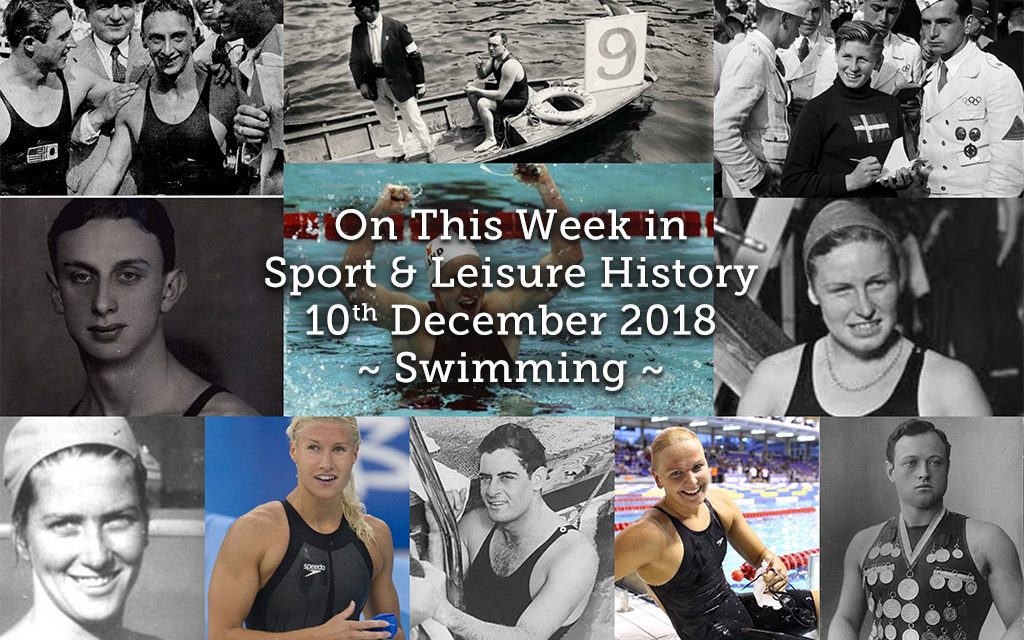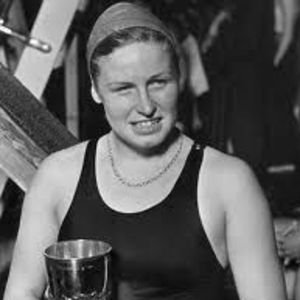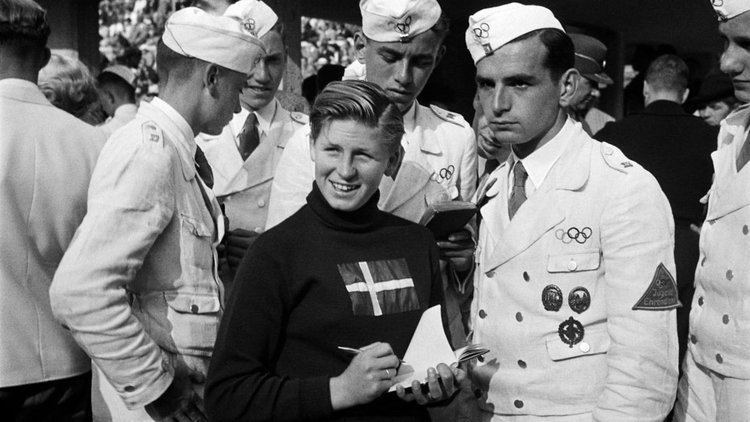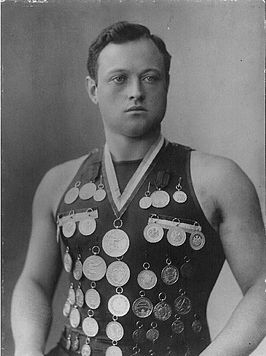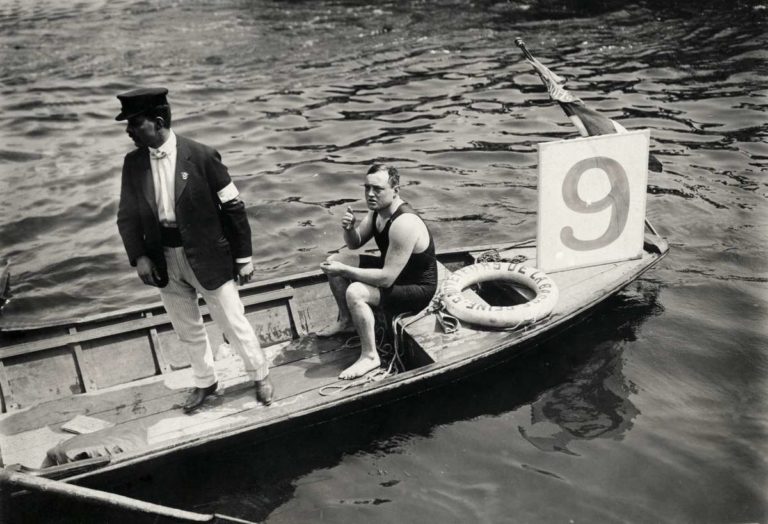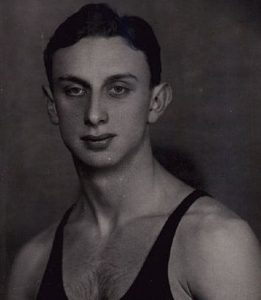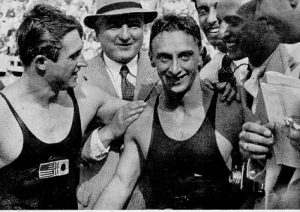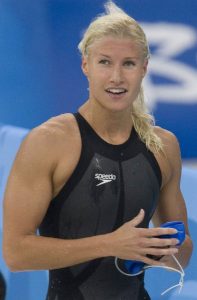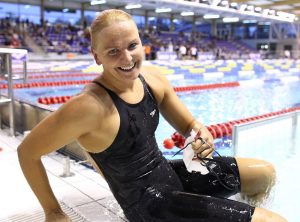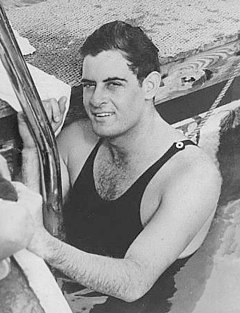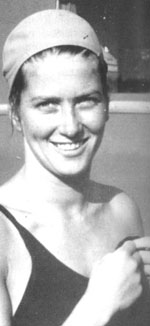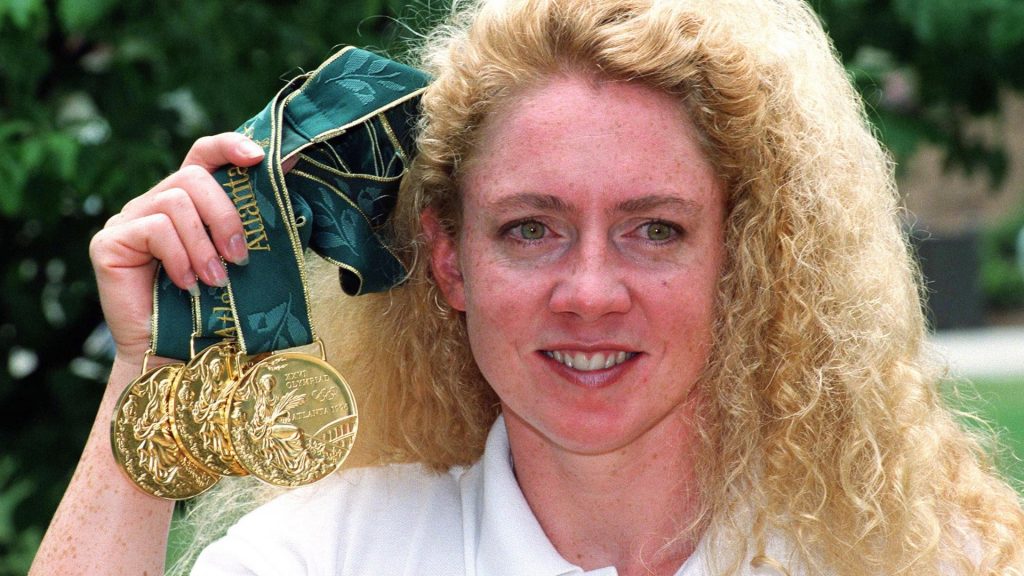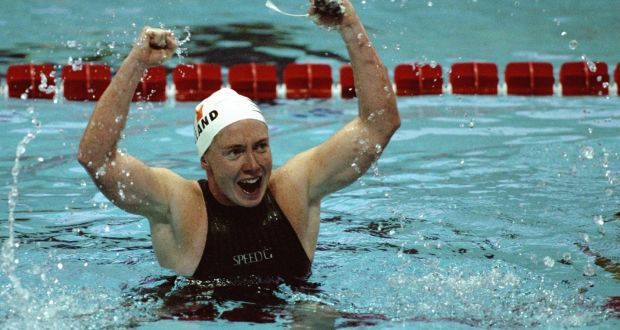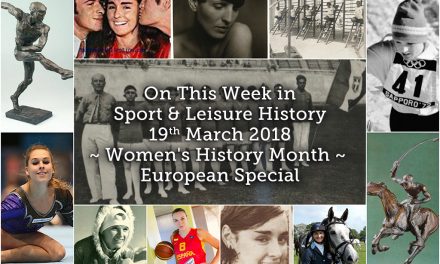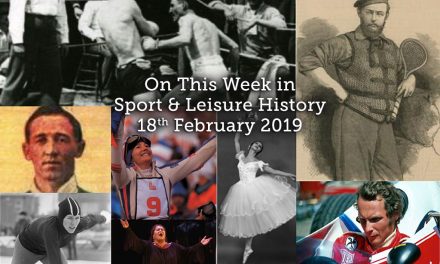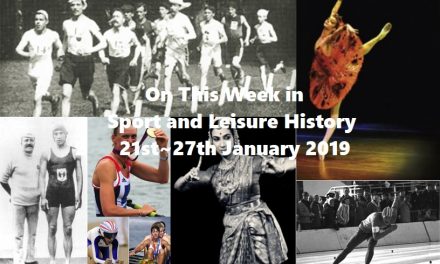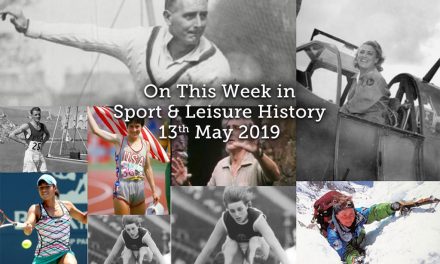With the World Short Course Swimming Championships taking place this week in Hangzhou, China, Playing Pasts takes a look at 7 swimming stars from bygone years
10th
Ragnhild Hveger, who was born in Nyborg in Denmark on this day in 1920, was considered the “female Johnny Weissmuller” of her day and the most extraordinary swimmer ever by many swimming historians. Unlike Weissmuller, she did not get much media attention, mainly due to the fact that she was in her “prime” during the years around WWII. Her father was a train driver who had strong ties to the Danish National Socialist Workers Party. Ragnhild took up competitive swimming in 1932 at the age of 12 and made her international debut at the 1936 Olympics, where she won silver in the 400m freestyle, when she was only 15. She next competed at the 1938 European Championships in London, where she won golds in the 100m and 400m freestyle and 4×100 free relay and was nicknamed “The Golden Torpedo” by The Times after winning the 400m freestyle by nearly half a pool length, beating runner-up Dutch Rie van Veen by almost 20 seconds. Between 1936-43 she set 44 world records, mostly in freestyle, in distances from 200m to 1500m, but also one in the 200m backstroke, and in 1941 alone, she set 19 world records. However, the later part of her career was marred by her family’s close association with the Nazis. Her father had risen to a high rank in the Danish National Socialist Workers Party and her brother was a volunteer with the Waffen SS fighting on the Eastern Front. Her popularity was often used as a propaganda tool by the Nazis, which resulted in her marrying a German officer in 1943, retirement from swimming, and moving to Kiel to work as a swimming instructor. After the war, her popularity had declined so much that she had to work as a swimming instructor in Sweden and only returned to Denmark in 1948 with the intention of competing at the 1948 Olympics. But the Danish Olympic Committee put her amateur status in question, referring to her work as a swimming instructor and placed her on a two-year probation to restore her amateur status. Thus, she competed at her second Olympics in 1952, where she led the 400m freestyle final to the last 300m, but finished fifth. She also helped the Danish 4×100 m relay team to fourth place. She finally retired from competitive swimming in 1954, with all her world records still unbroken, and later led a secluded life, very rarely making public appearances and giving interviews. Ragnhild was elected to the International Swimming Hall of Fame in 1966 and in 1996 was named Danish female athlete of the 20th century by the Danish Olympic Committee. In 1999 she was named one of the top 10 swimmers of the 20th century, either male or female, by Swimming World magazine. The other nine selected had won 29 Olympic gold medals between them, while Ragnhild was the only one with none. She died at the age of 90 on 1st December 2011.
11th
Often referred to as the “Father of Dutch swimming” Pieter Lodewijk “Piet” Ooms was born today in 1884 in Amsterdam. Affliated to DJK in the city he represented his country in both swimming and water polo at the Olympic Games of 1908. Piet is one of the earliest sportsmen from Holland known aboard – In France there is a commemorative plaque of Piet after winning a very tough open water race. In this way he became an international sports celebrity, just like skater and cyclist Jaap Eden and Janus Ooms, a rower also from Amsterdam, the pair are not related, despite sharing the same surname. Piet started out as a swimmer in short distances but became internationally known for his long distance efforts. In 1952, in a Radio interview he said “I started when I was eleven years old. When I was eighteen, I won the championship of Holland….. I got bored in Holland”. At the age of 21 I swam the Traversé de Paris – 12 kilometers long. I was second”. He was probably the first Dutch athlete with a personal coach/trainer. From the start of his career, he worked with Bram Felleman, who provided everything, including a slug of champagne whenever Piet slumped in training – which Felleman jumped into the water to pour into the swimmer’s mouth. Piet died on 14th February in his home city of Amsterdam at the age of 76.
- Piet with his coach Bram Felleman
12th
Hungarian Ferenc Csik was born on this day in 1913, a medical student from Budapest in 1936 when he was the surprise winner of 100m freestyle at the Olympics. Although reigning European 100m free champion, he was not considered among the favourites to win the Olympic title – it was thought that either world record holder American Peter Fick (who incidentally was also shares the same birth-date as Ferenc) or the strong Japanese swimmers Masanori Yusa, Shigeo Arai and Masaharu Taguchi. At the Olympic final, as the favourites battled each other, Ferenc came through in the outside lane to finish ahead of three Japanese swimmers, while Fick finished a disappointing sixth. Ferenc also win bronze in the 4x200m free relay at these Olympics. He grew up on the shores of Lake Balaton and started swimming at an early age, but took up competitive swimming seriously only after enrolling at University in Budapest, where he studied medicine. Ferenc was the youngest of three brothers, whose father was killed during the first months of the World War I. He became the top Hungarian freestyle swimmer of the 1930s, first competing internationally at the 1933 World University Games, where he won 100m freestyle silver and 50m freestyle bronze. The next year he won the 100m free and 4x200m free relay at the 1934 European Championships. In 1935, at the World University Games he won the 100m free, 4x200m free relay, and medley relay and after his Olympic triumph, he last competed internationally at the 1937 World University Games, winning the 100m free, 200m breaststroke, 4x200m free relay, and medley relay. Domestically he was a 19-time Hungarian champion and part of three Hungarian 4×100 m freestyle relay teams that set world records, clocking 4:10.2 in June 1937, 4:06.6 in August 1937 and 4:02.0 in July 1938. Ferenc graduated from in 1937 with an MD degree and retired from international competition, concentrating on his work while continuing to compete domestically, winning his final medals at the Hungarian championships in 1942. In 1943, he taught anatomy at the Budapest University of Physical Education and also worked as an editor Of an Hungarian medical journal. In October 1944 he was mobilized to the Army, serving as an Army medic in Szolnok, Keszthely, and Sopron. Just a month before the end of World War II, on 29th March 1945, Sergeant Ferenc Csik was killed in an air raid in Sopron, while treating the wounded. He was inducted into International Swimming Hall of Fame in 1983.
- Ferenc after his 1936 victory
13th
Hanna-Maria Seppälä, who was born on this day in 1984, is a Finnish freestyle swimmer who won the world 100m freestyle title at the 2003 World Championships in Barcelona, She started swimming at the age of 5 at the Keravan Uimarit club and made the Finnish national junior team by age 10. In 1999 she won the bronze medal in the European Junior Championships in the 50m freestyle and to date she has broken 100 Finnish national records. Another swimmer who shares the same birthday is Otylia Jędrzejczak from Poland who was born in 1983, she was Poland’s first Olympic champion in swimming. She achieved this at the Athens Olympics in the 200m butterfly, without doubt her strongest distance. In that event, she has also won two world championships in 2003 and 2005, four European titles between 2000 and 2006 and three European short-course golds in 2001 and 2006-07. She also broke the world record in this distance three times, her only international title in another event came at the 2006 Europeans, when she claimed gold in the 200m freestyle. She has also medalled in the 400m free at the Athens Games (silver), and won one Olympic and three World Championship medals in the 100m butterfly. After her golden race in Greece she auctioned off her medal, with the proceeds (around US$ 80,000) going to combat leukaemia in a local children’s hospital. Her career was badly interrupted when she crashed her car into a tree during bad weather, killing her 19-year-old brother Szymon, who was also a swimmer. Refusing to take a suspended prison sentence, she was eventually convicted on appeal, and sentenced to community service and a suspension of her driving license. Although continuing to swim, her performances gradually declined, and she missed the finals in both major tournaments of 2008, the Europeans and the Olympics, after which she retired.
- Hanna-Maria Seppälä
- Otylia Jędrzejczak
14th
Born on this day in 1918 – Ralph Drew Flanagan – American Olympic swimmer who represented his country at two consecutive Olympic Games. As a 13-year-old at the 1932 Olympics in Los Angeles, Flanagan competed in the semi-finals of the 1500m freestyle. Four years later at the 1936 Olympics in Berlin, Germany, he won a silver medal as a member of the second-place US team in the 4×200m freestyle relay. Individually, he finished fourth in the 400-meter freestyle and fifth in the 1500m freestyle. He swam for the Miami Swimming Club and the Miami Biltmore Aquatic Club. He also won 20 AAU titles and set 26 American and two world records and at one time held every American freestyle record from 220y to one mile. After his retirement he stayed in swimming as a Red Cross professional and later was the director of safety programs for Los Angeles. He was inducted in the International Swimming Hall of Fame as an “Honor Swimmer” in 1978 and died on 8th February 1988.
15th
Romana Calligaris was born on this day in 1924 in Mariano del Friuli in Italy. She won 15 national titles between 1947 and 1953 and competed at the 1952 Olympics in the 100m freestyle and the 4x100m relay, failing to reach the final on both occasions. The pool which hosted the 2005 European Short Course Championships in Trieste is named after Romana Calligaris. She died at the age of 767 in that city on 21st April 2002.
16th
Michelle Marie Smith (later De Bruin) was born on this day in 1969 in Dublin. Taught to swim by her father she was first spotted by a lifeguard in Tallaght swimming pool when she was 9, she was encouraged to join the Terenure Swimming Club where she trained under Larry Williamson. She won the Dublin and All-Ireland Community Games at 9 years old and in 1980 enrolled in the King’s Hospital Swimming Club. At 14 she won ten medals at the Irish National Swimming Championships abd became National Junior and Senior Champion and dominated Irish women’s swimming until her retirement in 1998. She first appeared on the world scene as an 18-year-old at the Seoul Olympics and only narrowly missed the semi-finals. Her second major championship was at the 1991 World Championships in Perth, where she finished 13th in the 400m individual medley. She competed at the 1991 European Championships and qualified for the 1992 Olympic Games, where she contested the 200m medley and backstroke and 400m medley despite suffering an injury in the months leading up to the Games. In 1993 she trained by Erik de Bruin, whom she had met in Barcelona and would later marry. She finished fifth in the 200m butterfly at the 1994 World Championships. In that same year, she had suffered glandular fever, which affected her training prior to the World Championships. In 1995, she set Irish records in 50m, 100 m, 400 m and 800 m freestyle, 100m backstroke, 100m and 200m butterfly, and 200m and 400m medley events. She was ranked number 1 in 200m butterfly, sixth in 100m butterfly and seventh in 200m medley; she made sporting history by becoming the first Irishwoman to win a European title in 200m butterfly and the individual 400m medley in the same year. At the Atlanta Olympics she became Ireland’s most decorated Olympian, but her sudden improvement in performance immediately caused various doping rumours, which could not be substantiated. With her husband being suspended for doping use in 1993, rumours persisted throughout the Atlanta Games, where she won four medals, including titles in both medley events and the 400m freestyle. Her title in the latter event was also controversial because the Americans had lodged a protest claiming she had been entered the race after the deadline, but the protest was not upheld. She won two more European titles in 1997, before her career came to a sudden halt in January 1998. In an out-of-competition drug test, she handed in a urine sample that had been tampered with. This was considered to be equal to a positive sample, and she was suspended for four years, effectively ending her career.

